Neolithic Revolution: Difference between revisions
Broken css was fixed. No need for previous article edit now. |
m Copyedited, removed irrelevant word |
||
| Line 1: | Line 1: | ||
{{Neolithic}} |
{{Neolithic}} |
||
The '''Neolithic Revolution''' is the first [[Agriculture|agricultural]] revolution—the transition from [[hunter-gatherer|hunting and gathering]] to [[agriculture]] and settlement. Archaeological data indicate that various forms of [[domestication]] of plants and animals arose independently in six separate locales worldwide, with the earliest known evidence "found throughout the tropical and subtropical areas of southwestern and southern Asia, northern |
The '''Neolithic Revolution''' is the first [[Agriculture|agricultural]] revolution—the transition from [[hunter-gatherer|hunting and gathering]] to [[agriculture]] and settlement. Archaeological data indicate that various forms of [[domestication]] of plants and animals arose independently in six separate locales worldwide, with the earliest known evidence "found throughout the tropical and subtropical areas of southwestern and southern Asia, northern |
||
and central Africa and Central America... ca. 10,000–7000 |
and central Africa and Central America... ca. 10,000–7000 years [[Before Present|BP]] (8,000-5000 BC).<ref>[http://www.ias.ac.in/currsci/jul102004/54.pdf "Origin of agriculture and domestication of plants and animals linked to early Holocene climate amelioration", Anil K. Gupta*, Current Science, Vol. 87, No. 1, 19 october 2010]</ref> |
||
However, the Neolithic Revolution involved far more than the adoption of a limited set of food-producing techniques. During the next millennia it would transform the small and mobile groups of hunter-gatherers that had hitherto dominated human history, into sedentary [[society|societies]] based in built-up [[Village|villages]] and [[town]]s, which radically modified their [[natural environment]] by means of specialized food-crop cultivation (e.g., [[irrigation]] and food storage [[technology|technologies]]) that allowed extensive surplus food production. These developments provided the basis for concentrated high [[population density|population densities]] settlements, specialized and complex [[division of labour|labor diversification]], [[trade|trading economies]], the development of non-portable [[art]], [[architecture]], and [[culture]], centralized administrations and political structures, hierarchical [[ideology|ideologies]] and depersonalized systems of knowledge (e.g., [[property|property regimes]] and [[history of writing|writing]]). The first full-blown manifestation of the entire [[Neolithic]] complex is seen in the Middle Eastern [[Sumer]]ian cities (ca. [[3,500 BC]]), whose emergence also inaugurates the end of the prehistoric Neolithic period. |
However, the Neolithic Revolution involved far more than the adoption of a limited set of food-producing techniques. During the next millennia it would transform the small and mobile groups of hunter-gatherers that had hitherto dominated human history, into sedentary [[society|societies]] based in built-up [[Village|villages]] and [[town]]s, which radically modified their [[natural environment]] by means of specialized food-crop cultivation (e.g., [[irrigation]] and food storage [[technology|technologies]]) that allowed extensive surplus food production. These developments provided the basis for concentrated high [[population density|population densities]] settlements, specialized and complex [[division of labour|labor diversification]], [[trade|trading economies]], the development of non-portable [[art]], [[architecture]], and [[culture]], centralized administrations and political structures, hierarchical [[ideology|ideologies]] and depersonalized systems of knowledge (e.g., [[property|property regimes]] and [[history of writing|writing]]). The first full-blown manifestation of the entire [[Neolithic]] complex is seen in the Middle Eastern [[Sumer]]ian cities (ca. [[3,500 BC]]), whose emergence also inaugurates the end of the prehistoric Neolithic period. |
||
Revision as of 23:17, 2 January 2011
| The Neolithic |
|---|
| ↑ Mesolithic |
| ↓ Chalcolithic |
The Neolithic Revolution is the first agricultural revolution—the transition from hunting and gathering to agriculture and settlement. Archaeological data indicate that various forms of domestication of plants and animals arose independently in six separate locales worldwide, with the earliest known evidence "found throughout the tropical and subtropical areas of southwestern and southern Asia, northern and central Africa and Central America... ca. 10,000–7000 years BP (8,000-5000 BC).[1]
However, the Neolithic Revolution involved far more than the adoption of a limited set of food-producing techniques. During the next millennia it would transform the small and mobile groups of hunter-gatherers that had hitherto dominated human history, into sedentary societies based in built-up villages and towns, which radically modified their natural environment by means of specialized food-crop cultivation (e.g., irrigation and food storage technologies) that allowed extensive surplus food production. These developments provided the basis for concentrated high population densities settlements, specialized and complex labor diversification, trading economies, the development of non-portable art, architecture, and culture, centralized administrations and political structures, hierarchical ideologies and depersonalized systems of knowledge (e.g., property regimes and writing). The first full-blown manifestation of the entire Neolithic complex is seen in the Middle Eastern Sumerian cities (ca. 3,500 BC), whose emergence also inaugurates the end of the prehistoric Neolithic period.
The relationship of the above-mentioned Neolithic characteristics to the onset of agriculture, their sequence of emergence and empirical relation to each other at various Neolithic sites remains the subject of academic debate, and seems to vary from place to place, rather than being the outcome of universal laws of social evolution.[2][3]
Agricultural transition
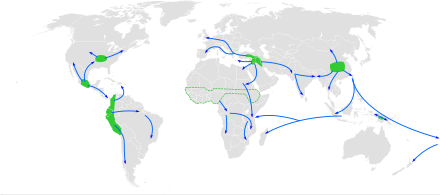
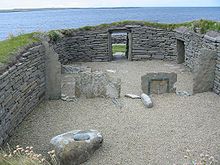
The term Neolithic Revolution was coined in the 1920s by Vere Gordon Childe to describe the first in a series of agricultural revolutions in Middle Eastern history. The period is described as a "revolution" to denote its importance, and the great significance and degree of change affecting the communities in which new agricultural practices were gradually adopted and refined.
The beginning of this process in different regions has been dated from perhaps 8000 BC in Melanesia[5][6] to 2500 BC in Subsaharan Africa, with some considering the developments of 9000-7000 BC in the Fertile Crescent to be the most important. This transition everywhere seems associated with a change from a largely nomadic hunter-gatherer way of life to a more settled, agrarian-based one, with the inception of the domestication of various plant and animal species—depending on the species locally available, and probably also influenced by local culture.
There are several competing (but not mutually exclusive) theories as to the factors that drove populations to take up agriculture. The most prominent of these are:
- The Oasis Theory, originally proposed by Raphael Pumpelly in 1908, popularized by Vere Gordon Childe in 1928 and summarised in Childe's book Man Makes Himself.[7] This theory maintains that as the climate got drier due to the Atlantic depressions shifting northward, communities contracted to oases where they were forced into close association with animals, which were then domesticated together with planting of seeds. However, today this theory has little support amongst archaeologists because climate data for the time actually shows that at the time, the climate of the region was getting wetter rather than drier.[8]
- The Hilly Flanks hypothesis, proposed by Robert Braidwood in 1948, suggests that agriculture began in the hilly flanks of the Taurus and Zagros mountains, where the climate was not drier as Childe had believed, and fertile land supported a variety of plants and animals amenable to domestication.[9]
- The Feasting model by Brian Hayden[10] suggests that agriculture was driven by ostentatious displays of power, such as giving feasts, to exert dominance. This required assembling large quantities of food, which drove agricultural technology.
- The Demographic theories proposed by Carl Sauer[11] and adapted by Lewis Binford[12] and Kent Flannery posit an increasingly sedentary population that expanded up to the carrying capacity of the local environment and required more food than could be gathered. Various social and economic factors helped drive the need for food.
- The evolutionary/intentionality theory, developed by David Rindos[13] and others, views agriculture as an evolutionary adaptation of plants and humans. Starting with domestication by protection of wild plants, it led to specialization of location and then full-fledged domestication.
- Ronald Wright's book and Massey Lecture Series A Short History of Progress[14] makes a case for the development of agriculture coinciding with an increasingly stable climate.
- The postulated Younger Dryas impact event, claimed to be in part responsible for megafauna extinction, and which ended the last ice age, could have provided circumstances that required the evolution of agricultural societies for humanity to survive. The agrarian revolution itself is a reflection of typical overpopulation by certain species following initial events during extinction eras; this overpopulation itself ultimately propagates the extinction event.
In contrast to the Paleolithic (2.6 million years ago to 10,000 BC) in which several hominid species existed, only one (Homo sapiens) reached the Neolithic.
Domestication of plants
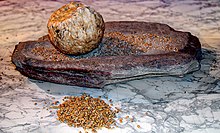
Once agriculture started gaining momentum, cereal grasses (beginning with emmer, einkorn and barley), and not simply those that would favour greater caloric returns through larger seeds, were selectively bred. Plants that possessed traits such as small seeds or bitter taste would have been seen as undesirable. Plants that rapidly shed their seeds on maturity tended not to be gathered at harvest, thus not stored and not seeded the following season; years of harvesting selected for strains that retained their edible seeds longer. Several plant species, the "pioneer crops" or Neolithic founder crops, were the earliest plants successfully manipulated by humans. Some of these pioneering attempts failed at first and crops were abandoned, sometimes to be taken up again and successfully domesticated thousands of years later: rye, tried and abandoned in Neolithic Anatolia, made its way to Europe as weed seeds and was successfully domesticated in Europe, thousands of years after the earliest agriculture.[15] Wild lentils present a different challenge that needed to be overcome: most of the wild seeds do not germinate in the first year; the first evidence of lentil domestication, breaking dormancy in their first year, was found in the early Neolithic at Jerf el-Ahmar, (in modern Syria), and quickly spread south to the Netiv HaGdud site in the Jordan Valley.[15] This process of domestication allowed the founder crops to adapt and eventually become larger, more easily harvested, more dependable in storage and more useful to the human population.
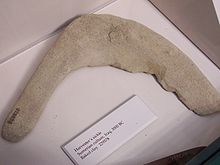
Figs, barley and, most likely, oats were cultivated in the Jordan Valley, represented by the early Neolithic site of Gilgal, where in 2006[16] archaeologists found caches of seeds of each in quantities too large to be accounted for even by intensive gathering, at strata dateable c. 11,000 years ago. Some of the plants tried and then abandoned during the Neolithic period in the Ancient Near East, at sites like Gilgal, were later successfully domesticated in other parts of the world.
Once early farmers perfected their agricultural techniques, their crops would yield surpluses that needed storage. Most hunter gatherers could not easily store food for long due to their migratory lifestyle, whereas those with a sedentary dwelling could store their surplus grain. Eventually granaries were developed that allowed villages to store their seeds longer. So with more food, the population expanded and communities developed specialized workers and more advanced tools.
The process was not as linear as was once thought, but a more complicated effort, which was undertaken by different human populations in different regions in many different ways.
Agriculture in Asia
The Neolithic Revolution is believed to have become widespread in southwest Asia around 8000 BC–7000 BC, though earlier individual sites have been identified. Although archaeological evidence provides scant evidence as to which of the genders performed what task in Neolithic cultures, by comparison with historical and contemporary hunter-gatherer communities it is generally supposed that hunting was typically performed by the men, whereas women had a more significant role in the gathering. By extension, it may be theorised that women were largely responsible for the observations and initial activities that began the Neolithic Revolution, insofar as the gradual selection and refinement of edible plant species was concerned.[citation needed]
The precise nature of these initial observations and (later) purposeful activities that would give rise to the changes in subsistence methods brought about by the Neolithic Revolution are not known; specific evidence is lacking. However, several reasonable speculations have been put forward; for example, it might be expected that the common practice of discarding food refuse in middens would result in the regrowth of plants from the discarded seeds in the (fertilizer-enriched) soils. In all likelihood, a number of factors contributed to the early onset of agriculture in Neolithic human societies.
Agriculture in the Fertile Crescent
Generalised agriculture apparently first arose in the Fertile Crescent because of many factors. The Mediterranean climate has a long dry season with a short period of rain, which made it suitable for small plants with large seeds, like wheat and barley. These were the most suitable for domestication because of the ease of harvest and storage and the wide availability. In addition, the domesticated plants had especially high protein content. The Fertile Crescent had a large area of varied geographical settings and altitudes. The variety given made agriculture more profitable for former hunter-gatherers. Other areas with a similar climate were less suitable for agriculture because of the lack of geographic variation within the region and the lack of availability of plants for domestication.
Agriculture in Africa
The Revolution developed independently in different parts of the world, not just in the Fertile Crescent. On the African continent, three areas have been identified as independently developing agriculture: the Ethiopian highlands, the Sahel and West Africa.[17]
The most famous crop domesticated in the Ethiopian highlands is coffee. In addition, Khat, Ensete, Noog, teff and finger millet were also domesticated in the Ethiopian highlands. Crops domesticated in the Sahel region include sorghum and pearl millet. The Kola nut, extracts from which became an ingredient in Coca Cola, was first domesticated in West Africa. Other crops domesticated in West Africa include African rice, African yams and the oil palm.[17]
A number of crops that have been cultivated in Africa for millennia came after their domestication elsewhere. Agriculture in the Nile River Valley developed from crops domesticated in the Fertile Crescent. Bananas and plantains, which were first domesticated in Southeast Asia, most likely Papua New Guinea, were re-domesticated in Africa possibly as early as 5,000 years ago. Asian yams and taro were also cultivated in Africa.[17]
Prof. Fred Wendorf and Dr. Romuald Schild, of the Department of Anthropology at Southern Methodist University, originally thought to have found evidence of early agriculture in Upper Paleolithic times at Wadi Kubbaniya, on the Kom Ombos plateau, of Egypt, including a mortar and pestle, grinding stones, several harvesting implements and charred wheat and barley grains—which may have been introduced from outside the region. Accelerator Mass Spectrometry (AMS) dating since their first reports has invalidated their hypothesis.[18]
Many such grinding stones are found with the early Egyptian Sebilian and Mechian cultures and evidence has been found of a neolithic domesticated crop-based economy dating around 5000 BC.[19] Philip E. L. Smith[20] writes: "With the benefit of hindsight we can now see that many Late Paleolithic peoples in the Old World were poised on the brink of plant cultivation and animal husbandry as an alternative to the hunter-gatherer's way of life". Unlike the Middle East, this evidence appears as a "false dawn" to agriculture, as the sites were later abandoned, and permanent farming then was delayed until 4500 BC with the Tasian and Badarian cultures and the arrival of crops and animals from the Near East.
Agriculture in the Americas
Corn, beans and squash were among the earliest crops domesticated in Mesoamerica, with Maize beginning about 7500 BC, squash, as early as 8000 to 6000 BC and beans by no later than 4000 BC. Potatoes and manioc were domesticated in South America. In what is now the eastern United States, Native Americans domesticated sunflower, sumpweed and goosefoot around 2500 BC.[17]
Domestication of animals
When hunter-gathering began to be replaced by sedentary food production it became more profitable to keep animals close at hand. Therefore, it became necessary to bring animals permanently to their settlements, although in many cases there was a distinction between relatively sedentary farmers and nomadic herders. The animals' size, temperament, diet, mating patterns, and life span were factors in the desire and success in domesticating animals. Animals that provided milk, such as cows and goats, offered a source of protein that was renewable and therefore quite valuable. The animal’s ability as a worker (for example ploughing or towing), as well as a food source, also had to be taken into account. Besides being a direct source of food, certain animals could provide leather, wool, hides, and fertilizer. Some of the earliest domesticated animals included dogs (about 15,000 years ago),[21] sheep, goats, cows, and pigs.
Domestication of animals in the Middle East
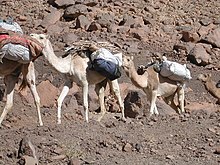
The Middle East served as the source for many animals that could be domesticated, such as goats and pigs. This area was also the first region to domesticate the Dromedary Camel. The presence of these animals gave the region a large advantage in cultural and economic development. As the climate in the Middle East changed, and became drier, many of the farmers were forced to leave, taking their domesticated animals with them. It was this massive emigration from the Middle East that would later help distribute these animals to the rest of Afroeurasia. This emigration was mainly on an east-west axis of similar climates, as crops usually have a narrow optimal climatic range outside of which they cannot grow for reasons of light or rain changes. For instance, wheat does not normally grow in tropical climates, just like tropical crops such as bananas do not grow in colder climates. Some authors like Jared Diamond postulated that this East-West axis is the main reason why plant and animal domestication spread so quickly from the Fertile Crescent to the rest of Eurasia and North Africa, while it did not reach through the North-South axis of Africa to reach the Mediterranean climates of South Africa, where temperate crops were successfully imported by ships in the last 500 years.[citation needed] The African Zebu is a separate breed of cattle that was better suited to the hotter climates of central Africa than the fertile-crescent domesticated bovines. North and South America were similarly separated by the narrow tropical Isthmus of Panama, that prevented the andes llama to be exported to the Mexican plateau.
Consequences of the Neolithic Revolution
Social change
It is often argued that agriculture gave humans more control over their food supply, but this has been disputed by the finding that nutritional standards of Neolithic populations were generally inferior to that of hunter gatherers, and life expectancy may in fact have been shorter, in part due to diseases.[citation needed] Average height, for example, went down from 5' 10" (178 cm) for men and 5' 6" (168 cm) for women to 5' 3" (165 cm) and 5' 1" (155 cm), respectively and it took until the twentieth century for average human height to come back to the pre-Neolithic Revolution levels.[22] These sedentary groups were able to reproduce at a faster rate due to the possibilities of sharing the raising of children in such societies. The children accounted for a denser population, and encouraged the introduction of specialization by providing diverse forms of new labor. The development of larger societies seemed to have led to the development of different means of decision making and to governmental organization. Food surpluses made possible the development of a social elite who were not otherwise engaged in agriculture, industry or commerce, but dominated their communities by other means and monopolized decision-making.
Subsequent revolutions
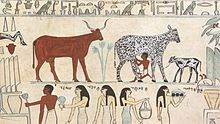
Andrew Sherratt has argued that following upon the Neolithic Revolution was a second phase of discovery that he refers to as the secondary products revolution. Animals, it appears were first domesticated purely as a source of meat.[23] The Secondary Products Revolution occurred when it was recognised that animals also provided a number of other useful products. These included:
- hides and skins (from undomesticated animals)
- manure for soil conditioning (from all domesticated animals)
- wool (from sheep, llamas, alpacas, and Angora goats)
- milk (from goats, cattle, yaks, sheep, horses and camels)
- traction (from oxen, onagers, donkeys, horses and camels)
Sherratt argues that this phase in agricultural development enabled humans to make use of the energy possibilities of their animals in new ways, and permitted permanent intensive subsistence farming and crop production, and the opening up heavier soils for farming. It also made possible nomadic pastoralism in semi arid areas, along the margins of deserts, and eventually led to the domestication of both the dromedary and bactrian camel. Overgrazing of these areas, particularly by herds of goats, greatly extended the areal extent of deserts. Living in one spot would have more easily permitted the accrual of personal possessions and an attachment to certain areas of land. From such a position, it is argued, prehistoric people were able to stockpile food to survive lean times and trade unwanted surpluses with others. Once trade and a secure food supply were established, populations could grow, and society would have diversified into food producers and artisans, who could afford to develop their trade by virtue of the free time they enjoyed because of a surplus of food. The artisans, in turn, were able to develop technology such as metal weapons. Such relative complexity would have required some form of social organisation to work efficiently, so it is likely that populations that had such organisation, perhaps such as that provided by religion, were better prepared and more successful. In addition, the denser populations could form and support legions of professional soldiers. Also, during this time property ownership became increasingly important to all people. Ultimately, Childe argued that this growing social complexity, all rooted in the original decision to settle, led to a second Urban Revolution in which the first cities were built.[citation needed]
Disease

Throughout the development of sedentary societies, disease spread more rapidly than it had during the time in which hunter-gatherer societies existed. Inadequate sanitary practices and the domestication of animals may explain the rise in deaths and sickness during the Neolithic Revolution, as diseases jumped from the animal to the human population. Some examples of diseases spread from animals to humans are influenza, smallpox, and measles.[citation needed] In concordance with a process of natural selection, the humans who first domesticated the big mammals quickly built up immunities to the diseases as within each generation the individuals with better immunities had better chances of survival. In their approximately 10,000 years of shared proximity with animals, Eurasians and Africans became more resistant to those diseases compared with the indigenous populations encountered outside Eurasia and Africa.[24] For instance, the population of most Caribbean and several Pacific Islands have been completely wiped out by diseases. According to the Population history of American indigenous peoples, 90% of the population of certain regions of North and South America were wiped out long before direct contact with Europeans. Some cultures like the Inca Empire did have one big mammal domesticated, the Llama, but the Inca did not drink its milk or live in a closed space with their herds, hence limiting the risk of contagion.
The causal link between the type or lack of agricultural development, disease and colonisation is not supported by colonization in other parts of the world. Disease increased after the establishment of British Colonial rule in Africa and India despite the areas having diseases for which Europeans lacked natural immunity. In India agriculture developed during the Neolithic period with a wide range of animals domesticated. During colonial rule an estimated 23 million people died from cholera between 1865 and 1949, and millions more died from plague, malaria, influenza and tuberculosis.In Africa European colonisation was accompanied by great epidemics, including malaria and sleeping sickness and despite parts of colonised Africa having little or no agriculture Europeans were more susceptible than these Africans. The increase of disease has been attributed to increased mobility of people, increased population density, urbanisation, environmental deterioration and irrigation schemes that helped to spread malaria rather than the development of agriculture.[25]
Technology
In his book Guns, Germs, and Steel, Jared Diamond argues that Europeans and East Asians benefited from an advantageous geographical location that afforded them a head start in the Neolithic Revolution. Both shared the temperate climate ideal for the first agricultural settings, both were near a number of easily domesticable plant and animal species, and both were safer from attacks of other people than civilizations in the middle part of the Eurasian continent. Being among the first to adopt agriculture and sedentary lifestyles, and neighboring other early agricultural societies with whom they could compete and trade, both Europeans and East Asians were also among the first to benefit from technologies such as firearms and steel swords. In addition, they developed resistances to infectious disease, such as smallpox, due to their close relationship with domesticated animals. Groups of people who had not lived in proximity with other large mammals, such as the Australian Aborigines and American indigenous peoples were more vulnerable to infection and largely wiped out by diseases.
During and after the Age of Discovery, European explorers, such as the Spanish conquistadors, encountered other groups of people who had never or only recently adopted agriculture, such as in the Pacific Islands, or lacked domesticated big mammals such as the people of the New Guinea Highlands.
Archeogenetics
The dispersal of Neolithic culture from the Middle East has recently been associated with the distribution of human genetic markers. In Europe, the spread of the Neolithic culture has been associated with distribution of the E1b1b lineages and Haplogroup J that are thought to have arrived in Europe from North Africa and the Near East respectively.[26][27] In Africa, the spread of farming, and notably the Bantu expansion, is associated with the dispersal of Y-chromosome haplogroup E1b1a from West Africa.[26]
See also
- Çatalhöyük, a Neolithic site in southern Anatolia
- Natufians, a settled culture preceding agriculture
- Original affluent society
- Haplogroup G (Y-DNA)
- Haplogroup J2 (Y-DNA)
- Haplogroup J (mtDNA)
- Agricultural Revolution
- Neolithic tomb
- Surplus product
- Göbekli Tepe
References
- ^ "Origin of agriculture and domestication of plants and animals linked to early Holocene climate amelioration", Anil K. Gupta*, Current Science, Vol. 87, No. 1, 19 october 2010
- ^ "The Slow Birth of Agriculture", Heather Pringle*
- ^ "Zawi Chemi Shanidar", EMuseum, Minnesota State University
- ^ Attention: This template ({{cite doi}}) is deprecated. To cite the publication identified by doi:10.1126/science.1078208, please use {{cite journal}} (if it was published in a bona fide academic journal, otherwise {{cite report}} with
|doi=10.1126/science.1078208instead. - ^ Denham, Tim P. (2003). "Origins of Agriculture at Kuk Swamp in the Highlands of New Guinea". Science. 301 (5630): 189–193. doi:10.1126/science.1085255. PMID 12817084.
{{cite journal}}: Unknown parameter|coauthors=ignored (|author=suggested) (help) - ^ The Kuk Early Agricultural Site
- ^ Gordon Childe (1936). Man Makes Himself. Oxford university press.
- ^ Scarre, Chris (2005). "The World Transformed: From Foragers and Farmers to States and Empires" in The Human Past: World Prehistory and the Development of Human Societies (Ed: Chris Scarre). London: Thames and Hudson. Page 188. ISBN 0-500-28531-4
- ^ Charles E. Redman (1978). Rise of Civilization: From Early Hunters to Urban Society in the Ancient Near East. San Francisco: Freeman.
- ^ Hayden, Brian (1992). "Models of Domestication". In Anne Birgitte Gebauer and T. Douglas Price (ed.). Transitions to Agriculture in Prehistory. Madison: Prehistory Press. pp. 11–18.
- ^ Sauer, Carl, O (1952). Agricultural origins and dispersals. Cambridge, MA: MIT Press.
{{cite book}}: CS1 maint: multiple names: authors list (link) - ^ Binford, Lewis R. (1968). "Post-Pleistocene Adaptations". In Sally R. Binford and Lewis R. Binford (ed.). New Perspectives in Archaeology. Chicago: Aldine Publishing Company. pp. 313–342.
- ^ Rindos, David (1987). The Origins of Agriculture: An Evolutionary Perspective. Academic Press. ISBN 978-0125892810).
{{cite book}}: Check|isbn=value: invalid character (help); Unknown parameter|month=ignored (help) - ^ Wright, Ronald (2004). A Short History of Progress. Anansi. ISBN 0-88784-706-4).
{{cite book}}: Check|isbn=value: invalid character (help) - ^ a b Weiss, Ehud (2006). "Autonomous Cultivation Before Domestication". Science. 312 (5780): 1608–1610. doi:10.1126/science.1127235. PMID 16778044.
{{cite journal}}: Cite has empty unknown parameter:|month=(help); Unknown parameter|coauthors=ignored (|author=suggested) (help) - ^ "Tamed 11,400 Years Ago, Figs Were Likely First Domesticated Crop".
- ^ a b c d Diamond, Jared (1999). Guns, Germs, and Steel. New York: Norton Press. ISBN 0-393-31755-2.
- ^ DR Harris, HE Gove, P Damon "The Impact on Archaeology of Radiocarbon Dating by Accelerator Mass Spectrometry" Philosophical Transactions of the Royal Society of London A323, 23-43 1987 [1]
- ^ The Cambridge History of Africa
- ^ Smith, Philip E.L., Stone Age Man on the Nile, Scientific American Vol. 235 No. 2, August 1976
- ^ McGourty, Christine (2002-11-22). "Origin of dogs traced". BBC News. Retrieved 2006-11-29.
- ^ The Borderlands of Science by Michael Shermer. p. 250
- ^ Sherratt 1981
- ^ Guns, Germs, and Steel: The Fates of Human Societies - Jared Diamond, 1997
- ^ Marshall, P. J. Ed. (1996), Cambridge illustrated History: British Empire, Cambridge University Press, ISBN 0-521-00254-0, p. 142
- ^ a b Semino, O; Magri, C; Benuzzi, G; Lin, AA; Al-Zahery, N; Battaglia, V; MacCioni, L; Triantaphyllidis, C; Shen, P; et al. (2004). "Origin, Diffusion, and Differentiation of Y-Chromosome Haplogroups E and J: Inferences on the Neolithization of Europe and Later Migratory Events in the Mediterranean Area". American journal of human genetics. 74 (5): 1023–34. doi:10.1086/386295. PMC 1181965. PMID 15069642.
{{cite journal}}: Explicit use of et al. in:|last=(help) - ^ Lancaster, Andrew (2009). "Y Haplogroups, Archaeological Cultures and Language Families: a Review of the Multidisciplinary Comparisons using the case of E-M35" (PDF). Journal of Genetic Genealogy. 5 (1).
Further reading
- Bailey, Douglass. (2000). Balkan Prehistory: Exclusions, Incorporation and Identity. Routledge Publishers. ISBN 0-415-21598-6.
- Bailey, Douglass. (2005). Prehistoric Figurines: Representation and Corporeality in the Neolithic. Routledge Publishers. ISBN 0-415-33152-8.
- Balter, Michael (2005). The Goddess and the Bull: Catalhoyuk, An Archaeological Journey to the Dawn of Civilization. New York: Free Press. ISBN 0-7432-4360-9.
- Bellwood, Peter. (2004). First Farmers: The Origins of Agricultural Societies. Blackwell Publishers. ISBN 0-631-20566-7
- Cohen, Mark Nathan (1977)The Food Crisis in Prehistory: Overpopulation and the Origins of Agriculture. New Haven and London: Yale University Press. ISBN 0-300-02016-3.
- Diamond, Jared (1999). Guns, Germs, and Steel: The Fates of Human Societies. New York: Norton Press. ISBN 0-393-31755-2.
- Diamond, Jared (2002) Evolution, Consequences and Future of Plant and Animal Domestication. Nature Magazine, Vol 418.
- Grinin, L. 2007. Periodization of History: A theoretic-mathematical analysis. In: History & Mathematics. Moscow: KomKniga/URSS. P.10-38. ISBN 9785484010011.
- Harlan, Jack R. (1992) Crops & Man: Views on Agricultural Origins ASA, CSA, Madison, WI. http://www.hort.purdue.edu/newcrop/history/lecture03/r_3-1.html
- Wright, Gary A. (1971) "Origins of Food Production in Southwestern Asia: A Survey of Ideas" Current Anthropology, Vol. 12,
No. 4/5 (Oct - Dec., 1971) , pp. 447–477
- Bartmen, Jeff M. (2008) Disease.
- House of Anansi Press page for the book
- CBC Radio, Ideas, page on the Massey Lectures 2004 also includes streaming audio of Chapter 1 of 5
- Chapter I - Gauguin's Questions
- Stu’s Notes #11 a useful summary of many selected passages from the book
- Civilization is a Pyramid Scheme an online copy of Wright's earlier short article
- Chapter I podcast at http://www.radio4all.net (note this site is notoriously unreliable but it does come back up eventually)
- Chapter II podcast at http://www.radio4all.net
- An Interview with Ronald Wright, April 10, 2005, EcoTalk on Air America podcast at http://www.radio4all.net
- Evidence for food storage and predomestication granaries 11,000 years ago in the Jordan Valley [2].
